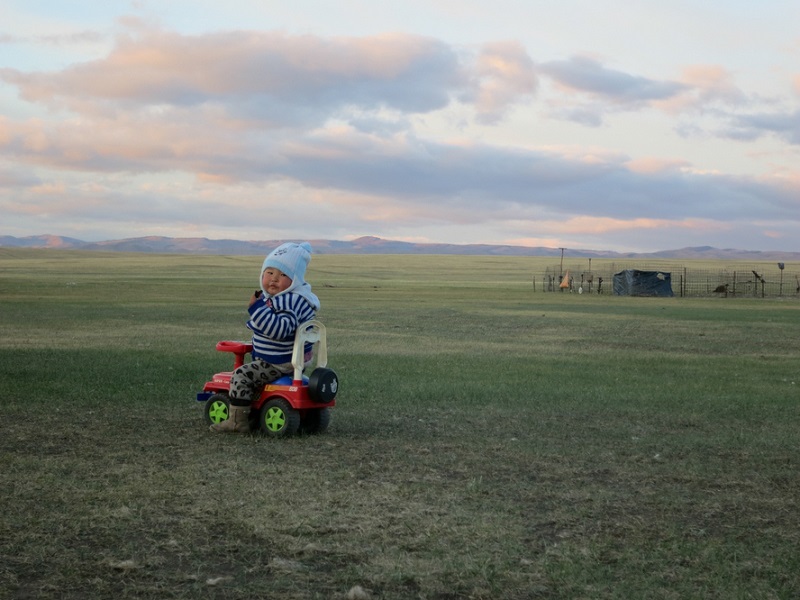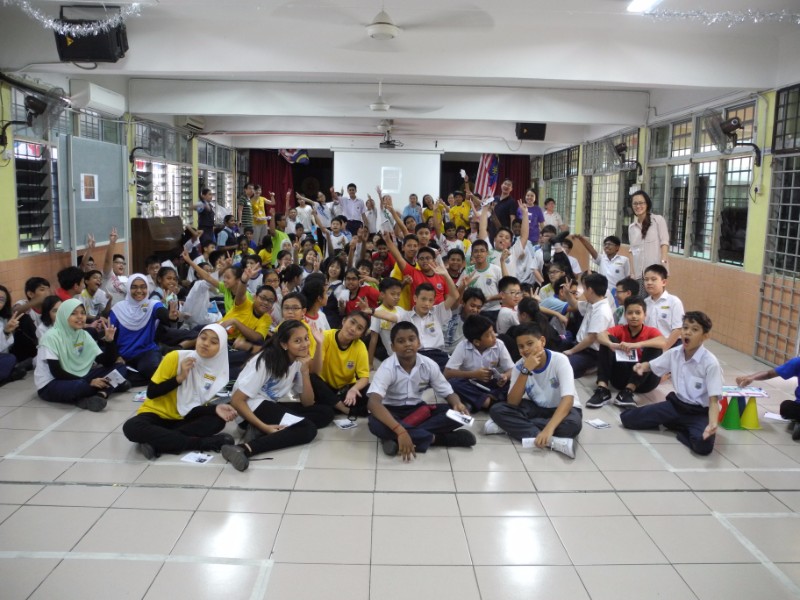
ActonKL Founding Story : Part 3 – Growing Experiments
In June 2015, I left banking for the second time to do “peer learning” experiments. Like my travels 3.5 years earlier, I gave myself two years.
After the Ramly Burger experiments, we explored further with two private groups. One with a church group and another with Caryn’s private tutoring group. It was tough engagement, due to language boundaries and a limited number of participants. Also, we were introducing hard concepts such as geometry. The first lesson was a complete failure.
Failure seemed to loom ahead.
Before telling you more about the struggles, I want to introduce two friends in these early days of peer learning experiments. Shien Jin had been the key person to exchange ideas in this peer learning experiment, right from Day One. His background spans Finance, Math, and Computer Science and Mathematics. More importantly, he likes to keep the execution light and simple—imagine clean code. Caryn was in Malaysia’s youth development and community building scene. She had juggled with a full-time job and was tutoring since her high school years. She has a certain connection with children, probably attributed to a bubbly personality, petite size, and a charming smile!
Back to the looming failure. So, we realized we could not fight with certain pre-conceptions with Mathematics.
Pivot to Coding
We decided to pivot. Coding, based on code.org. Here’s a platform which has engagement data analytics, scaffold lessons, completely free and funded by the major companies in Silicon Valley. Our guinea pig students loved it.
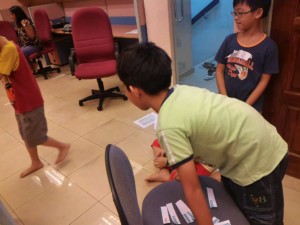
giving codes to a robot (DUMC Support Group in Kota Damansara)
Still, we needed to see how much we could scale this. Could one group of children “teach” another? We needed at least 50 students.
I recalled that I had plenty of downtime during the last two months of Primary School (after the major UPSR exams) in 1996. So I thought: are any schools willing to try some coding classes? I called several schools in Petaling Jaya. Many of the students had plenty of free time. The dynamic of post-UPSR free time is still true in 2015 as it was in 1996. I also learned that almost every public schools have Chromebook which are not fully utilized.
Free students for experiments! And free computers too!
The SK Taman Megah 160 students Challenge
One school we loved was SK Taman Megah. The senior management was courteous and supportive of us. However, they required our experiment to be inclusive—we could do the coding activities, but it must be for all their Standard 6 students. Yes, 160 of them.
So far, Caryn and I had been doing most of the experiments, with Shien Jin reviewing the lesson plans and pulling ideas from his experiences in Malaysian Computing Olympiad. But 160 students require more people to execute. So, enter Chun Te.
Chun Te has been the mastermind behind Creative Tech Camp, one of the pioneering technology and programming holiday camps in Kuala Lumpur. It turned out that he is my senior at Imperial College. With Shien Jin’s continuous traveling schedule, we still needed more people for 160 students. Enter the spouses: Audrey, Chun Te’s wife supported. So did Wei Wen (my wife). Julian, Caryn’s boyfriend (now husband) would have too but he was working in Singapore.
So, the five of us got ourselves into the school, only had the entire activity canceled due to haze. Nevertheless, we managed to run it the next day.
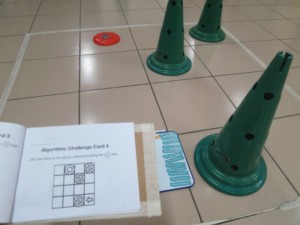
Unplugged activity using school cones
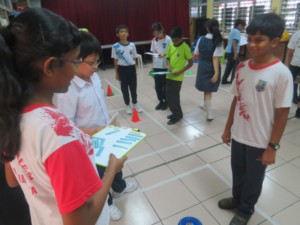
Learning in action! 40 students with no teachers… it’s closer to playing a game (and checking if each other is doing it right).

160 students. Well, 140+… few of them were not around.
Our two-days in SK Taman Megah was a success. The children loved it. We saw the empowerment when we appointed more capable students as coaches. Also, we replicated the same results in other schools too.
The experiments gave us insights on the possibility of peer learning and technology. You could see the novelty and simplicity of wrapping computer-based adaptive learning with a culture of coaching and feedback. Later, we did the same with 10 Standard 6 students running the plugged activities for almost all the Standard 4 and 5 students, in batches of 30-40 each time. Within two rounds of coaching, they were exchanging best practices.
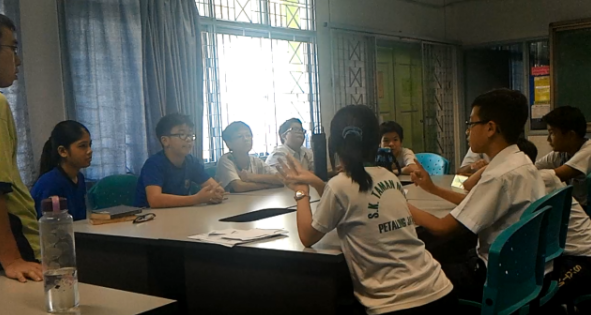
What worked? What did you struggle with? Each coaching session is muted by a discussion round of reflections.
We were blessed with public schools and students who gave us an opportunity to try out new things. The depth of the student’s feedback was second to none, as we interviewed several hours after each experiment to really hone in what worked and what we could improve on. Throughout these experiments, we were supported by Pn. Lee from SK Taman Megah, Sean Lip from Oppia / Google, and many other friends.
The ActonKL team today are those crazy ones who decided to work together on this project. All of us did it out of passion and curiosity, without any pay.
Great Results. But now what?
We engaged few partners around the KL area but we believe there is a clear difference in philosophy. We do peer learning, not teaching. We empower students, not instruct them. We want learning outcome, not a business model.
We have no idea where all these experiments will lead to. An alternative school, a community learning center or an online platform? Honestly, I had no clue and it seemed like a dead end.
In the last days of 2015, while reading more about blended school environments and micro-schools, I stumbled upon Acton Academy from this article. Acton Academy had all the similar ingredients of our vision of a peer learning community. And they had a website that anybody can start an Acton Academy. I read every single thing I could find about Acton Academy. Since there was nothing much I could do, why not apply to start an Acton Academy.
Shien Jin, being careful as he is. “A school? We haven’t even run any regular classes yet. This is a crazy idea!”
Well, I just smiled when he said it is crazy. It meant something worth doing. So, we applied using the portfolio of experiments and multiple edits from the team.
So, what are the chances? I did some math from this article. 64 applications a week and that the Acton Academy launch site started in 2014… there were probably 2,500 applications with only 25 licenses awarded in January 2016. None of them outside of the Americas. If we got it, we would be the first Acton Academy in Asia and the first one outside Americas.
Fingers crossed. We did what we could during the run-up to Chinese New Year of 2016.
Then, we got this email from Matt Clayton (who led the international expansion of Acton Academy):
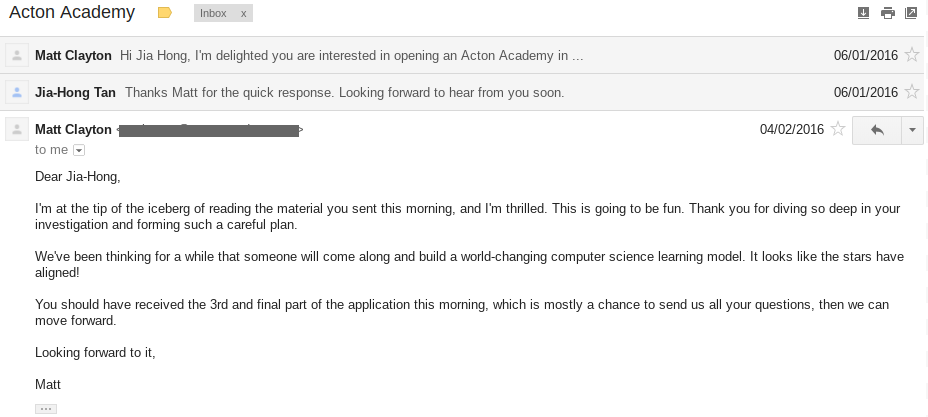
And the roller coaster journey was just getting started…


